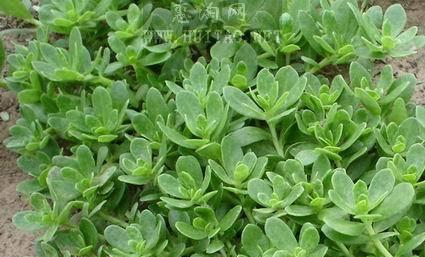Jingtian Sanqi, also known as Fei Cai, is called mosquito here in Jinzhou, Shijiazhuang, Hebei Province, where Rong Jie is located, and is a plant that can repel mosquitoes and relieve itching. And sedum sanchi, also known as soil sanchi, is a plant that can stop bleeding, relieve pain, disperse stasis and swelling, and the whole plant can be used as a medicinal use. The young leaves of Sedum Can also be used to stir-fry cold, which can be said to be a very good plant, which is very suitable for home farming, especially when there are many mosquitoes in summer. So how to raise it?

Replace the potting soil
After buying the sedum, do not rush to change the pot, you can wait until you adapt to some home environment, and then change the pot. There is also a change of pots for Sedum, preferably in the spring and autumn, because the spring and autumn season belongs to its growth period. If you change the pot in summer, you need to put it in a cool and ventilated place to slow the seedlings, and it is best to bring more potting soil to change the pot when changing the pot.
The soil used by Sedum Sanchi can use the humus soil after high temperature drying, and the garden soil can be mixed in the same proportion, and some decomposed manure can be added to the bottom of the pot, which is more conducive to the growth of Sedum Sanchi. After changing the pot, put it in a cool and ventilated place, slow the seedlings for about 7 to 10 days, and gradually accept the sunlight, and then you can maintain it normally.
Water in moderation
Watering Sedum needs to be timely and appropriate, such as noon watering in winter, morning and evening watering in summer, and morning and afternoon watering in spring and autumn. In addition, during the period of vigorous growth and the period of slow growth, the number of days between watering is also different.
Watering: Generally we water Sedum Sanchi, which can be done according to the principle of seeing dry and wet, that is, see dry and wet, not dry and not watered, and pour thoroughly. It is usually said that the soil is dry, that is, the water content in the soil is less, generally speaking, after 2/3 of the soil is dried, it is watered once.
There is also a need to water the sedum three seven, need to dry thoroughly water, do not water half cut water, to prevent the occurrence of wet and dry, resulting in the root system of the sedum three seven problems, the light will appear yellow leaves fall leaves, heavy easy to lead to the death of the sedum three seven.
Thin fertilizer is applied diligently
Sedum 37 does not like fertilizer very much, and can be properly fertilized during the growth period, which is conducive to the growth of Sedum 37. Generally speaking, we fertilize Jingtian Sanchi, you can follow the method of thin fertilizer application, do not use raw fertilizer or thick fertilizer, to prevent the occurrence of fertilizer damage and burning roots. So how do we fertilize?
Fertilization: In the three seasons of spring and autumn and summer, which belong to the vigorous growth period of Sedum Sanchi, we can wait about 15 to 20 days, it is a thin rotten cake fertilizer water, or buried after the decomposition of the cake fertilizer. In addition, nitrogen, phosphorus and potassium ternary compound fertilizer can also be used, which can play a role in promoting the growth of Sedum Panax notoginseng.
There are also young shoots after harvesting, you can also fertilize Sedum Sanchi once, which can play a role in promoting the growth of Sedum Sanchi, but also can make Sedum Sanchi grow more side branches, the plant type will become more rounded and full, the leaves are also more fat and turquoise, not only high ornamental value, but also edible.
Loved the lot of sunshine
Sedum likes plenty of sunlight, if the light is insufficient, it is easy to appear in the case of growth, and the leaves will become loose, and the branches will easily become octopus, thus affecting the ornamental value.
In the summer, when the sedum is three or seven, it can be raised in plenty of sunlight or in an environment with more scattered light. As long as there is more light, there will be no situation of discipleship in sedum.
There is also a summer sedum three seven, must be better ventilation, to prevent the occurrence of high temperature and high humidity, resulting in a lot of diseases and insect pests in the day of the sun.
Sedum sanchi is also called mosquito grass, its taste can not only play a role in anti-mosquito, and after mosquito bites, applying the wound has the effect of anti-itching and swelling, so that the wound heals quickly. There is also sedum sanchi can be used as a traditional Chinese medicine, which has many benefits for the body. You can also make food, which is very suitable for farming at home. We raise sedum three seven, as long as we buy it after choosing the right time to change the pot, after serving the pot to raise in plenty of sunlight, after the soil is dried, water once permeable, thin fertilizer and diligent fertilization, you can make the sedum three seven grow strong, ornamental value is very high. Is Sedum 37 your dish?